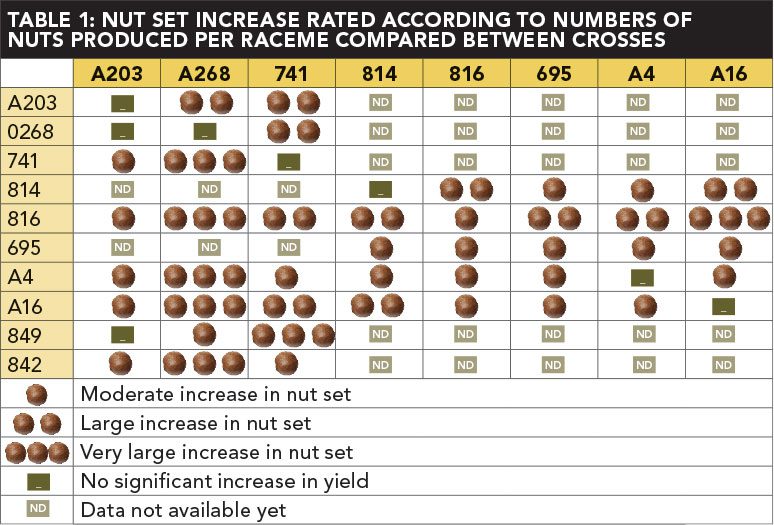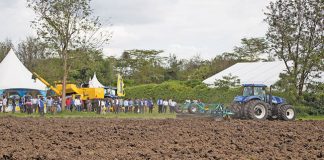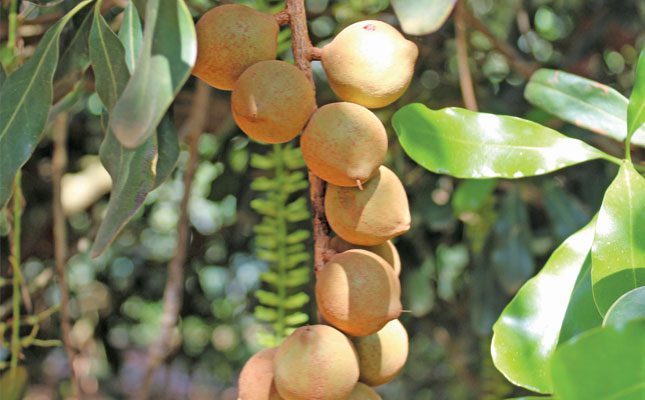
Photo: Lindi Botha
The price crash in the macadamia nut industry has alerted farmers to the need for greater on-farm efficiencies to weather the downturn. The industry is expected to recover but is unlikely to reach the record-high prices of 2018.
Cutting unnecessary costs and evaluating the performance of every step in the production process is a necessary step towards streamlining an industry. While this process has been forced on the macadamia industry in a bid to survive tight margins, it does place it in a better position for the future.
Mark Hassenkamp, director of RedSun Hortitech, adds that the disruption in the industry has provided an opportunity to pause and reflect. “What got us here won’t take us to the future and it’s essential to zoom out for a panoramic view of the macadamia industry, past and present.”
An insight this panoramic view provides is that the macadamia industry has for a large part ignored genetic selection and improvement, opting instead for an ‘anything goes as long as it gets into the soil’ approach.
Hassenkamp explains that the industry has unwittingly been multiplying poor-yielding genetics in the rush to get trees planted, while chasing the allure of white gold.
“By and large we have had no basis for determining tree vigour or desirable attributes in promoting yield, quality, disease tolerance, along with cultivar expression consistency and the combined effect of better profit through lower inputs per ton recovered.”
One of the major keys to all of this is genetics. Better genetics result in better yields, lower costs, reduced water usage, better quality and thereby improved market access. This, Hassenkamp believes, will result in an exponential return on investment in a focused strategy.
Historical disadvantage
Very little has been invested in cultivar improvement across the macadamia industry over the past few years. Hassenkamp says that the over nine million macadamia trees that have been planted in South Africa were established on seedling rootstocks, mostly Beaumont.
“Generally, we are not able to trace the multi-generational origin of the scion wood and rootstocks from those trees. What we do see is that yield performance within a single cultivar differs significantly, with both better and poorer results presented as we have moved further away from the original germplasm established. Our cultivars have become more varied as exponential propagation of trees has spread and successions of original selections have been taken from progeny many times removed from the original selections introduced to South Africa.”
Cultivar improvement is therefore a major opportunity and undertaking to build future and much-needed cultivar expression and yield, to bring higher tonnage and higher quality.
By focusing on genetics, the macadamia industry hopes to mimic the success of the apple industry, where yields have been taken from 50t/ha three decades ago to 100t/ha today.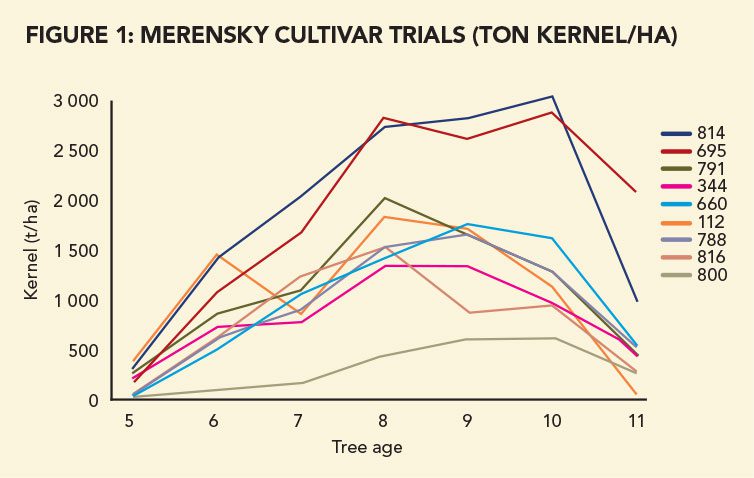
Surveying the genes
Understanding orchard performance down to tree performance has become a significant focus as the industry tries to regain profitability after the market shock.
Making a good start in this regard is RedSun Hortitech, together with Macadamias South Africa and the Agricultural Research Council, which are conducting a study on macadamia genes and expression.Some 34 macadamia cultivars have been planted in a single-variety block of 1ha each.
A statistical pattern has been applied to observe cultivar diversity in expression along with cultivar variances within the orchard. The orchard is now in its fourth year of production and providing valuable results.
“We are only just beginning to understand performance of individual trees within orchards, but we now have better data to see trends in overall cultivar adaptation to climate, altitudes, time to optimal yields and even time to cultivar yield decline from time of planting,” says Hassenkamp.
Ultimately, farmers must to be able to manage macadamia production to meet the cost-to-yield ratios achieved in other nut types to remain competitive. Since yield is by far the biggest determinant to a farmer’s success, varieties that do not yield should be eliminated.
Hassenkamp however points out that yield must be determined as the amount of marketable macadamia nuts versus the total unit cost.
This is underpinned by the majority style that the nuts provide, sound kernel recovery (SKR), pest and disease tolerance, and adaptation to climatic conditions. The latter is especially necessary to take into account since yield differences of the same cultivar are vastly different across growing regions.
The right mix
While it will be some time before genetic sequencing of macadamia-nut trees is completed and farmers have a clear indication of what cultivars to plant where, guidelines are emerging from ongoing research.
Philip Lee, a macadamia specialist from CompleteLee Nuts Consulting, says that cross-pollination alone can result in a 0,5t nut-in-shell (NIS) difference in yield. This means farmers need to choose at least two different cultivars to plant within a block.
Ideally, four should be considered. This ensures that farmers can hedge risk by spreading the production season across early-, middle- and-late maturing varieties.
Lee points to cultivar trials conducted in Tzaneen and Levubu in Limpopo and Burgers Hall in Mpumalanga to use as a sound base for decision-making.
In all three trials, planted in 1995 and continuously monitored since, the Beaumont is among the top two yielding cultivars. This led to the mass expansion of these orchards, which now make up nearly half of South Africa’s macadamia tree population.
Both cultivars 695 and 814 produced yields in this fully irrigated trial in excess of 4t/ha NIS from tree age eight to tree age 10.
The accumulated SKR of cultivar 814 from age five in 1998 to age 11 in 2004 reached 11 200kg, while accumulated SKR of 695 was 11 140kg. The lowest-producing cultivar, 800, had an accumulated yield of only 1 950kg of sound kernel from tree age five to 11.
Lee however notes that the cultivars that performed best in Tzaneen will not necessarily do the same in Empangeni. “But if one plants cultivar 800 in Tzaneen, no amount of fertiliser, irrigation or any other cultural management input is going to make it yield anywhere close to cultivar 695 or 814.”
A crucial factor the trials highlight is the importance of canopy management in maintaining consistently high yields. Lee notes that there was no tree training or pruning carried out in the trial up to tree age 11.
“The yield decline in all cultivars in this trial in 2004 was primarily caused by the dense canopies of all the trees (planted at a spacing of 8m by 4m and 312 trees per ha) which had grown to heights in excess of 8m by tree age 11. The lower yields were also aggravated by the severe drought of the 2003/04 season in the Tzaneen area (see Figure 1).
Even more important for the future of the macadamia industry is the potential for plant improvement indicated by the large difference between the highest- and lowest-yielding cultivars in this trial.
The highest-yielding cultivars – 695 and 814 – produced five times more nuts over the first seven years than the lowest-yielding cultivar – 800. This variance is what researchers are particularly hopeful about in gaining even higher yields with a more targeted breeding programme.
Lee explains that all the cultivars used in this trial, and which make up 90% of world production, came from first-generation selections from individual seeds.
“So, they are only one step away from the wild trees which still grow in the few patches of indigenous forest on the eastern seaboard of Australia.”
Fortunately, many of these wild trees have been identified in their natural habitat and preserved by the Australian Macadamia Trust, which has used this genetic diversity in its breeding programme.
It has released the first new cultivar, MCT1, under plant breeders’ rights protection, to the global macadamia industry. More cultivars can be expected from the MCT breeding programme in coming years, which Lee believes will no doubt provide even better yield and quality attributes.
Although the benefits of cross-pollination are not new, the industry has only recently started to understand just how big an impact it has on nut set and nut size, thereby improving both yield and quality when compared with nut production arising from self-pollination.
Macadamias are partially self-incompatible and cross-pollination is considered important to improve yields. However, questions remain regarding the importance of self- versus cross-pollination, and subsequently whether managed pollinators are useful in commercial orchards.
Lee refers to a study conducted in 2019 which showed that hand cross-pollinated racemes yielded significantly more nuts. Hand cross-pollinated racemes also produced significantly more developed nuts than open-pollinated racemes (all racemes were exposed to pollinators).
“These findings point to an opportunity to increase yields through additional cross-pollination, as high-intensity hand cross-pollination of flowering racemes within trees resulted in increased nut set.”
Research conducted in Australia by Prof Helen Wallace of Griffith University, adds to the unmistakeable conclusion that there is always better nut set, nut size and therefore better yield and quality when two cultivars are planted together in a block to optimise cross-pollination.
Wallace’s research was carried out in two blocks of 48 rows each of cultivar 816 next to cultivar Daddow. The research team of 10 people hand cross-pollinated some 40 000 racemes on 10 trees in the middle of each block and 10 trees at the edges of the blocks where a row of 816 was next to a row of Daddow.
By ensuring an abundance of cross-pollen in this way, yield of 816 trees hand-pollinated with Daddow pollen increased from
1,3t/ha NIS in the control trees (10 trees not hand-pollinated) in the centre of the block to 2,5t/ha NIS at the edge of the block.
For Daddow, the yield increase was from 2,8t/ha NIS to 3,9t/ha NIS in the centre row when hand-pollinated with 816 pollen and from 3,1t/ha NIS 4t/ha NIS in the edge row.
These results show that there were higher yields at block edges than in the centre of the blocks when trees are open-pollinated. On average, the yield benefit from hand cross-pollination in this research project was about 1t/ha NIS.
Lee states that while hand-pollinating trees is not practical, the research does show that at least 0,5t/ha NIS additional yield is achieved in open-pollinated trees when there is one row of one cultivar right next to a row of another cultivar.
“It is therefore worthwhile, and certainly practical, to plant two cultivars together
in every block of macadamias, either one row of cultivar A alternating with one row of cultivar B, or two rows alternating to ensure that there is always a different cultivar in the next row,” he says.
More research on this subject is necessary to provide details about which cultivars work best together. But the importance of having bees and other vectors in the orchards during flowering is undisputed.
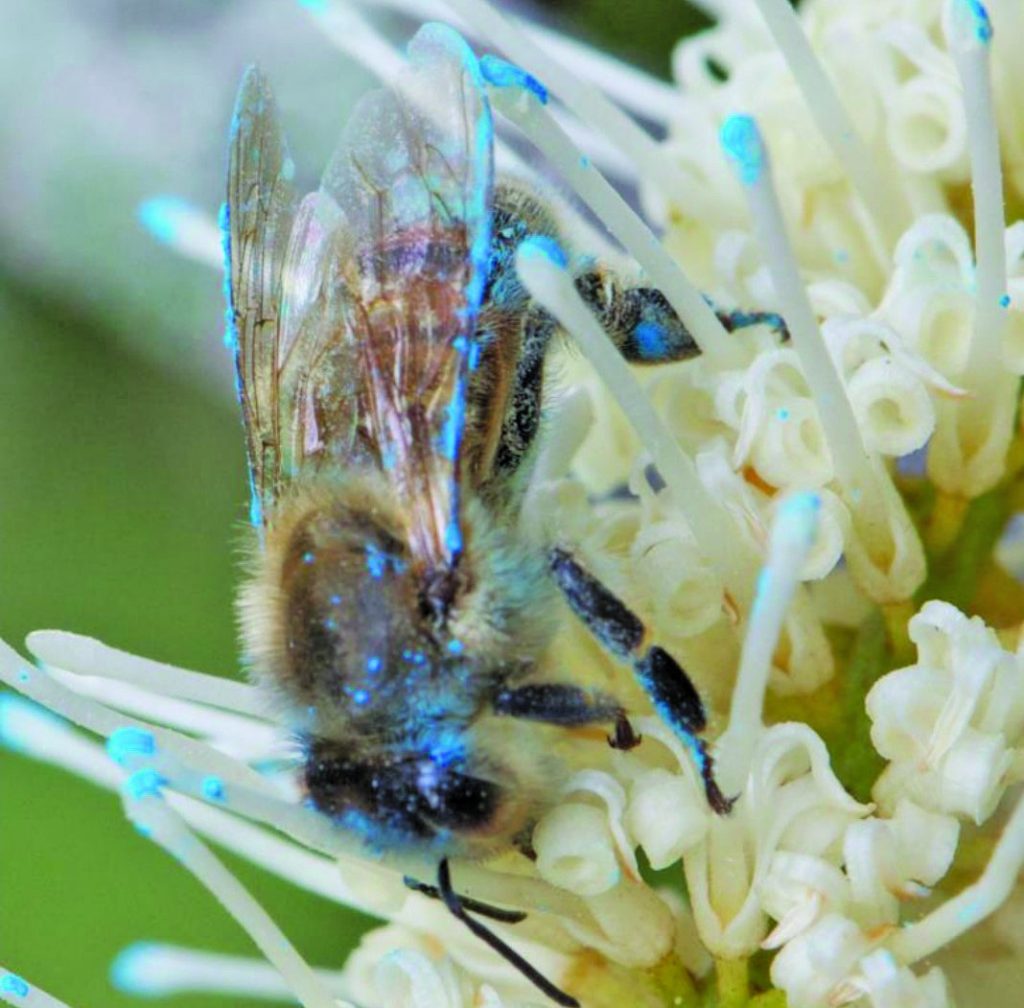
Future focus
As with all agriculture crops, the industry should become obsessive about identifying outstanding trees within cultivars, along with better appreciating cultivar and climatic performance under best-management practices.
Hassenkamp reiterates: “If we don’t measure it, we cannot manage it. This is both an on-farm and industry-wide dynamic that we will now invest in to take macadamia farming to the next level of yield recovery against back on-farm profitability per ton, hectare and tree.
“To grow and be a sustainable future global crop of scale, macadamia production must now quickly evolve from being a volume-driven novelty to a demand-driven commodity to compete.”
Until more improved macadamia cultivars become available, new growers must use every available source of information on yield and quality performance for their specific local area so as to make an educated decision on cultivar choice.
Email Mark Hassenkamp at [email protected], or Philip Lee at [email protected].

